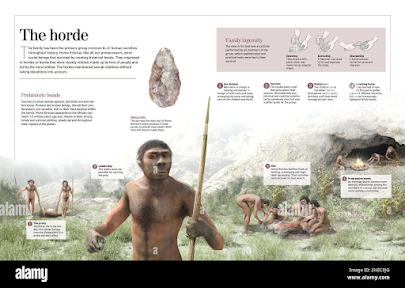EVOLUTION OF MAN
TOPIC: EVOLUTION OF MAN
Chapter 1: The Origins of Life and Early Evolution
Life on Earth began over 3.5 billion years ago with simple microorganisms. Over time, these life forms evolved into more complex organisms, including the first multicellular life. Around 500 million years ago, vertebrates appeared, leading to the development of early mammals. By the time the dinosaurs dominated the planet, small mammalian species had already begun evolving into different groups, setting the stage for primate evolution.
Chapter 2: The Beginning: Early Primates
The journey of human evolution began around 65 million years ago with the emergence of primates. These small, tree-dwelling mammals had grasping hands, forward-facing eyes, and flexible limbs. Over time, some primates evolved into larger and more intelligent species, eventually giving rise to the first hominins—our direct ancestors. The divergence of primates led to two major groups: prosimians (like lemurs) and anthropoids (monkeys and apes). The latter group continued evolving, giving rise to the great apes, including the lineage that would eventually lead to humans.
Chapter 3: Australopithecus: The Earliest Hominins
One of the first known hominins was Australopithecus, which lived around 4 to 2 million years ago. These early human ancestors walked on two legs (bipedalism), a crucial adaptation that freed their hands for tool use. Australopithecus afarensis, famously represented by the fossil "Lucy," is one of the best-known species from this period. Their ability to walk upright allowed them to explore various environments, which played a critical role in their survival and adaptation.
Chapter 4: Homo Habilis: The First Tool-Maker
Around 2.4 million years ago, Homo habilis appeared. This species is often referred to as the "handy man" because of its ability to create and use simple stone tools. Their brain size was larger than that of Australopithecus, indicating early signs of increased intelligence and problem-solving abilities. They were capable of using tools to process food, defend themselves, and perform basic hunting activities. This advancement marked the beginning of the tool-making culture that would define human progress.
Chapter 5: Homo Erectus: The Great Explorer
Approximately 1.8 million years ago, Homo erectus emerged. This species was taller, had a larger brain, and was the first to migrate out of Africa to Asia and Europe. They mastered fire, developed more advanced tools, and possibly had early forms of communication. The ability to control fire provided warmth, protection, and the means to cook food, leading to improved nutrition. They built rudimentary shelters and began forming small communities, indicating early social organization.
Chapter 6: Neanderthals: The Close Relatives
About 400,000 years ago, Neanderthals (Homo neanderthalensis) evolved in Europe and Asia. They were highly adapted to cold climates, had complex social structures, and buried their dead, suggesting early cultural and spiritual practices. Despite their intelligence and strength, they eventually went extinct around 40,000 years ago, possibly due to competition with modern humans or climate changes. However, genetic studies show that many modern humans carry small percentages of Neanderthal DNA, proving interbreeding between the two species.
Chapter 7: Homo Sapiens: The Modern Human
Our species, Homo sapiens, appeared around 300,000 years ago in Africa. With a highly developed brain, language abilities, and creative thinking, humans quickly spread across the globe. The development of agriculture, art, and technology allowed civilizations to flourish, leading to the advanced societies we see today. The cognitive revolution, occurring around 70,000 years ago, led to the emergence of abstract thinking, symbolic communication, and complex societal structures.
Chapter 8: The Agricultural Revolution
Around 10,000 years ago, humans began transitioning from a nomadic hunter-gatherer lifestyle to settled agricultural communities. This shift led to the domestication of plants and animals, allowing for food surpluses and the development of civilizations. Cities emerged, trade expanded, and complex social hierarchies formed. Written language, governance, and organized religion began shaping human societies, setting the foundation for the modern world.
Chapter 9: The Industrial and Technological Revolutions
The past few centuries have seen dramatic changes in human evolution through industrialization and technological advancements. The Industrial Revolution of the 18th and 19th centuries transformed agriculture, manufacturing, and transportation, leading to rapid urbanization. The 20th and 21st centuries brought digital and biomedical advancements, reshaping how humans interact with the world. The development of artificial intelligence, genetic engineering, and space exploration continues to push the boundaries of human potential.
Chapter 10: The Future of Human Evolution
Human evolution is an ongoing process. With advancements in genetics, artificial intelligence, and biotechnology, future humans may evolve in ways we cannot yet predict. Adaptations to new environments, space colonization, and technological enhancements could shape the next stage of human development. The increasing integration of technology with biology raises ethical and philosophical questions about what it means to be human.
Conclusion
The evolution of man is a remarkable story of survival, adaptation, and progress. From small primates to intelligent beings capable of shaping the world, our journey continues. As science uncovers more about our past, we gain deeper insights into our future and the endless possibilities of human potential. Understanding our evolutionary history not only helps us appreciate our existence but also prepares us for the challenges that lie ahead.












Comments
Post a Comment